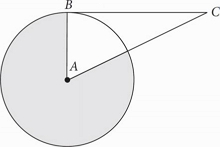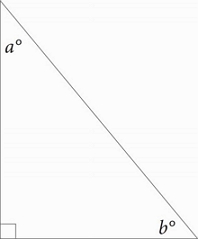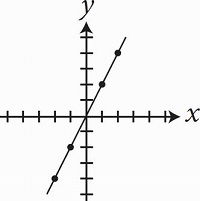
Note: Figure not drawn to scale.
The circle above with center A has an area of 21. BC is tangent to the circle with center A at point B. If AC = 2AB, then what is the area of the shaded region?
-
Solution
The trick is to recognize that ∠ABC is a 30°-60°-90° right triangle.
∠ABC must equal 90° since a tangent line must be perpendicular to the radius of a circle drawn to the point of tangency.
Only a 30°-60°-90° has a hypotenuse (AC) equal to double the length of one of the sides (AB). (You can also use the Pythagorean theorem to show this.)
This means that ∠BAC = 60°, so the shaded region has a central angle measure of 360° - 60° = 300°.
To get the area, use the proportion \(\frac{Central Angle}{360^{\circ}} = \frac{Sector Area}{Circle Area}, \;\; or \;\; \frac{300^{\circ}}{360^{\circ}} = \frac{s}{21}\).
Reduce, cross-multiply, and solve to get s = 17.5. This matches (C).

In the figure above, sin a = x. What is the value of cos b?
-
Solution
You can plug in when you're dealing with a geometry problem with unknowns.
When you're Plugging In for a right triangle, use one of the special right triangles to make your life easier.
Use a 3-4-5 right triangle. Make the side opposite a 3, the side adjacent to a 4, and the hypotenuse 5.
Because sine is \(\frac{opposite}{hypotenus}\), sin a = 3⁄5, so x = 3⁄5.
Cosine is \(\frac{adjacent}{hypotenus}\), so cosb = 3⁄5.
This is your target; circle it. Make x = 3⁄5 in each answer choice and look for the answer which equals 3⁄5. Only (A) works.

What is the value of tan ∠XZY ?
-
Solution
Tangent is defined as \(\frac{opposite}{adjacent}\).
The side opposite angle XZY is 7, and the side adjacent to this angle is 8, so the tangent of ∠XYZ = 7⁄8 , which is (C).

In the figure above, circle O has a radius of 8, and angle XOY measures 5⁄16π radians. What is the measure of minor arc XY ?
-
Solution
Because the question wants arc length and gives you the measure of the central angle in radians, you can use the formula s = rθ to find the arc length:
\(s = \left(8 \right) \left(\frac{5}{16}\pi \right) = \frac{40}{16}\pi\), which reduces to \(\frac{5}{2}\pi\), which is (B).

The figures above show the graphs of the functions f and g. The function f is defined by f(x) = 2x3 + 5x2 – x. The function g is defined by g(x) = f(x – h) – k, where h and k are constants. What is the value of hk ?
-
Solution
The second graph moves down 1 and to the left 1.
Remember that when a graph moves to the left, it is represented by (x + h), which would be the same as x - (-1).
So h = -1. Because a negative k represents moving down, k = 1.
Therefore, hk = (-1) × (1) = -1, and the correct answer is (B).
The graph of line l in the xy-plane passes through the points (2, 5) and (4, 11). The graph of line m has a slope of -2 and an x-intercept of 2. If point (x, y) is the point of intersection of lines l and m, what is the value of y ?
-
Solution
First, find the slope of line l by using the slope formula: \(\frac{y_{2} - y_{1}}{x_{2} - x_{1}} = \frac{11 - 5}{4 - 2} = \frac{6}{2} = 3\).
Plug this slope and one of the points on line l into the slope-intercept form y = mx + b to solve for b, giving you the full equation of the line.
If you use the point (2, 5), you get 5 = 3(2) + b or 5 = 6 + b, so b = -1.
Therefore, the equation for line l is y = 3x - 1.
For line m, the slope is given as -2, and the x-intercept is 2.
Be very careful not to jump to the conclusion that equation of line m is y = -2x + 2! In the form y = mx + b, the b is the y-intercept, not the x-intercept.
The x-intercept is where y = 0, so you know that (2, 0) is a point on line m.
Use this point and the slope to find the equation of line m in the same way you did for line l.
0 = -2(2) + b, so b = 4 and the equation is y = -2x + 4.
Now set the x parts of the equations equal to find the point of intersection.
If 3x - 1 = -2x + 4, then 5x = 5 and x = 1. Again, be careful! The question asked for the value of y ! Plug x = 1 into one of the line equations to find y.
For line l, the equation becomes y = 3(1) - 1 = 3 - 1 = 2, which is (D).

The graph above shows y = 2x. Which of the following graphs represents y = |2x|?

-
Solution
Try plugging in some values for x and see if the graphs include that point.
If x = 0, then y = 0, so (0, 0) should be a point on the graph.
Unfortunately this doesn't eliminate anything.
If x = 1, then y = 2, so (1, 2) should be a point on the graph.
Eliminate (B), (C), and (D).
Let the function f be defined such that f(x) = x2 – c, where c is a constant. If f(-2) = 6, what is the value of c ?
-
Solution
Start by plugging in what you know into the function given.
If f(x) = x2 - c, and f(-2) = 6, then plug in -2 for x in the function: f(-2) = (-2)2 - c.
Solve and replace f(-2) with 6: 6 = 4 - c; 2 = -c; and c = -2.
If you picked (A), you forgot that (-2)2 is positive 4.
If y = 3x and x and y are both integers, which of the following is equivalent to 9x + 3x + 1 ?
-
Solution
We've got variables in the answer choices, which means this is a perfect Plug In problem.
Since we can't use calculators, let's make up an easy value for x, such as 2.
9x + 3x+1 then becomes 92 + 32 + 1 = 81 + 27 = 108.
We plugged in x = 2, so let's use that to find y : y = 3x, so y = 32 = 9.
Now plug in y = 9 to each answer choice to see which one gives you 108.
Choice (C) is y(y + 3), which is 9(12) = 108, which is the correct answer.
If \(\frac{\sqrt{x}}{2} = 2\sqrt{2}\), what is the value of x ?
-
Solution
Plug in the answers, starting with (B).
If x = 16, the left side of the equation is \(\frac{\sqrt{16}}{2} = \frac{4}{2} = 2\).
Does that equal 2√2? No-it's too small.
Choice (C) is ugly to work with, so try (D) next.
If it is too big, (C) is your answer.
For (D), x = 32, and the left side of the equation becomes \(\frac{\sqrt{32}}{2} = \frac{\sqrt{16 \times 2}}{2} = \frac{4\sqrt{2}}{2} = 2\sqrt{2}\).
It's a match, so (D) is correct. You could also solve this algebraically.
Multiply both sides by 2 to get \(\sqrt{x} = 4\sqrt{2}\).
Square both sides to get x = 16 × 2 = 32.